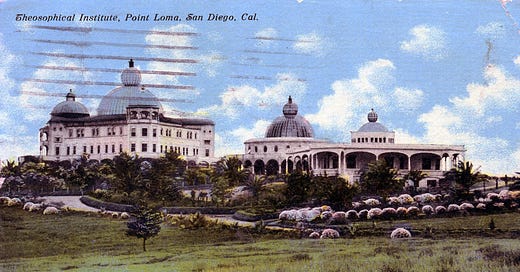Lomaland
Before it became the campus of Point Loma Nazarene University in 1973, the buildings on this peninsula in San Diego, California, belonged to the Theosophical Society and served as a proto-commune for adherents of this esoteric religion.
Following the death in 1891 of its founder Helena Petrovna Blavatsky (1831-1891), Katherine Tingley (1847-1929) moved the Theosophical Society headquarters to Point Loma, which soon became known as "Lomaland." The facility with its unusual architecture and even more unusual lifestyles became an important source of music and culture for residents of San Diego between 1900 and 1920.
Producing most of its own food, the society also experimented widely with planting trees and crops such as eucalyptus and avocado, giving that formerly barren part of Point Loma its current heavily wooded character. The campus was dominated by the imposing Academy Building and the adjoining Temple of Peace. The buildings were topped by amethyst domes, which were lighted at night and could be seen offshore. The entrance to the Academy Building was dominated by two massive carved doors that symbolized the theosophical principles of "spiritual enlightenment" and "human potential."
Lomaland dissolved in the aftermath of World War I and was used for bootlegging during the Prohibition era. The site was later taken over by Fort Rosecrans before World War II. This card was postmarked from San Diego on August 6, 1912, during Lomaland's heyday.



